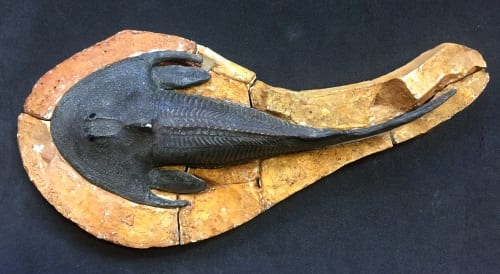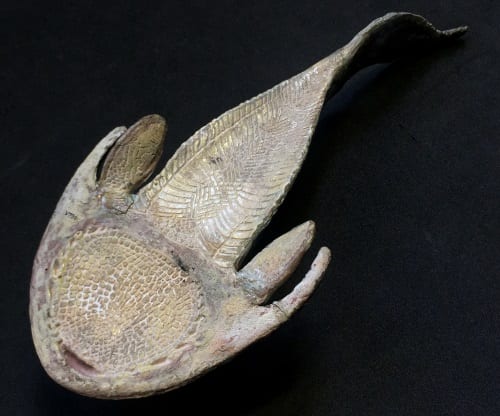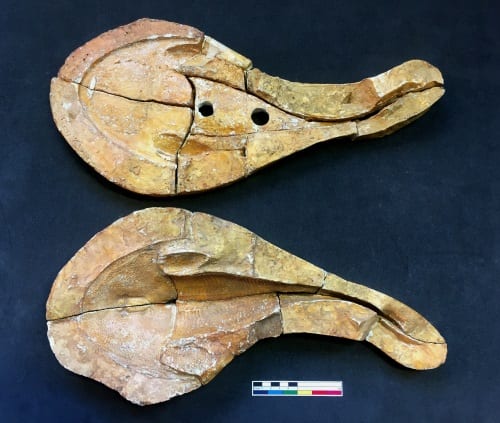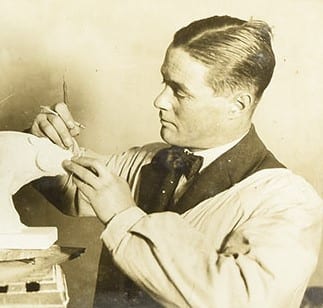Specimen of the Week 299 : The Cephalaspis Model and Mould
By Tannis Davidson, on 7 July 2017
This week’s Specimen of the Week pays tribute to one of the most influential natural history model makers of the 20th century, Vernon Edwards. A retired Navy commander, Edwards collaborated with scientists at the British Museum (Natural History) throughout the 1920’s – 1950’s creating reconstructions of extinct animals and geological dioramas.
His work was based on the latest palaeontological evidence and the combination of accuracy and high artistic quality ensured the popularity of the models which can found in museums, universities and collections around the world.
The Grant Museum is fortunate to have several painted plaster models made by Vernon Edwards – all of them models of extinct Devonian fish – as well as one of the original moulds. This blog previously highlighted Edwards’ Pteraspis models but this week’s model specimen is…
***The Cephalaspis Model and Mould***
This model and mould recreate the extinct armoured jawless fish Cephalaspis. It was a trout-sized fish which lived in the Early Devonian around 420 – 390 million years ago. As its name Cephalaspis (meaning “head shield”) describes, these fish featured a bony plate on the head which protected the head and gills and served as a defence against predators such as larger jawed placoderm fish and eurypterids.
The well-preserved fossil material of Cephalaspis has enabled palaeontologists to obtain much anatomical and biological information about these fish. The features of the animal are deftly modelled – the small eyes set on the top of the head, dorsal and pectoral fins and scale patterns. Also represented are the sensory patches in the centre and along the margins of the head shield which may have been used to sense vibrations of organisms burrowing in the mud.
Such details were possible to recreate due to the composition of the bony shield itself. This dermal skeleton was composed of three layers: an underlying ganoid scale made of connective tissue embedded with bone, a middle layer of spongy bone and a top layer of dentin 1. It is essentially a layer of enamel over a layer of pulp – virtually identical to our own teeth 2. The head shield, essentially made up of fused teeth, not only protected the animal in life, but also aided the preservation of internal structures such as the imprints of nerves and soft tissues.
The underside of the model is also highly detailed and features the small mouth opening, which given its placement on the bottom of the flat head suggests that it was a bottom-feeder possibly eating decomposing plant and animal parts:
The Grant Museum has two Vernon Edwards Cephalaspis models – one painted black (pictured in above images) and another painted light brown. During a recent audit, the painted ceramic mould was rediscovered – top and bottom, in 10 pieces:
While it is impossible to know for certain if this particular mould produced these very models, it is an exact match and identical in quality and colouration to known Vernon Edwards master moulds, many of which were recently on sale at a recent auction on his models, sketches and artwork.
The auctioned material originated from the historic collection of Gregory, Bottley & Lloyd, which was a renowned palaeontology and mineralogy supplier in London (founded in 1858). The business (known as Gregory Bottley & Co. until 1981) produced Edwards’plaster cast models of extinct animals which were mainly supplied to museums due to the fact that production was time-consuming which made the models expensive 3. A catalogue from 1957 lists the Cephalaspis salweyi model for £4 and 10 shillings (around £90 today) 4.
Prices and interest in Vernon Edwards appear to be on the rise as competitive bidding for lots met or exceeded nearly all pre-auction estimates. It is wonderful to see a renewed enthusiasm and appreciation of Vernon Edwards’ work. I hope that collections which have Edwards models appreciate them, not only in terms of monetary value, but as beautiful man-made specimens of scientific worth in their own right.
Tannis Davidson is the Acting Curator at the Grant Museum of Zoology
References
- Sansom, R. S. 2009. “Phylogeny, classification and character polarity of the Osteostraci (Vertebrata)”. Journal of Systematic Palaeontology. 7: 95–11. doi:10.1017
- Shubin, Neil. 2009. Your Inner Fish: A Journey into the 3.5 Billion Year History of the Human Body (reprint ed.). New York: Pantheon Books. pp. 85–86.
- Howgate, M.E. 2017. “Vernon Edwards Collection Lots 601-685”. Entry in Timeline Auctions Antiquities Catalogue. Sale Number 84 & 85. Timeline Auctions Limited.
- Gregory, Bottley & Co. 1957. A Catalogue of Plaster Cast Models of Extinct Animals.
One Response to “Specimen of the Week 299 : The Cephalaspis Model and Mould”
- 1
 Close
Close







I’m Vernon Edwards only granddaughter. Delighted to know his work is being recognized. He was entirely self taught. He created wonderful cartoon story books for my mother when she was a child. Vernon came from a large family, all of whom had great sense of humor and always playing pranks. His oldest brother was a ships surgeon in the China Seas, and Hugh Edwards became a popular author.